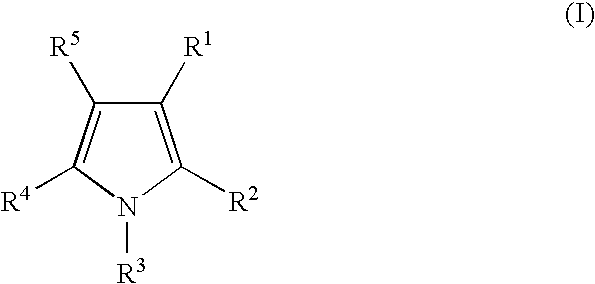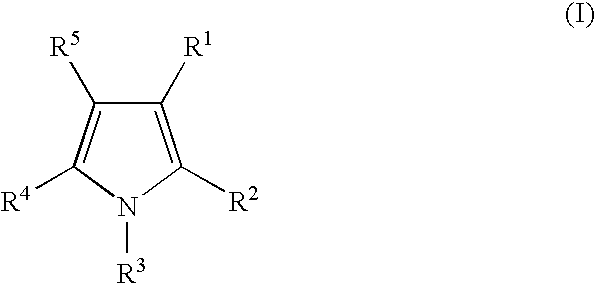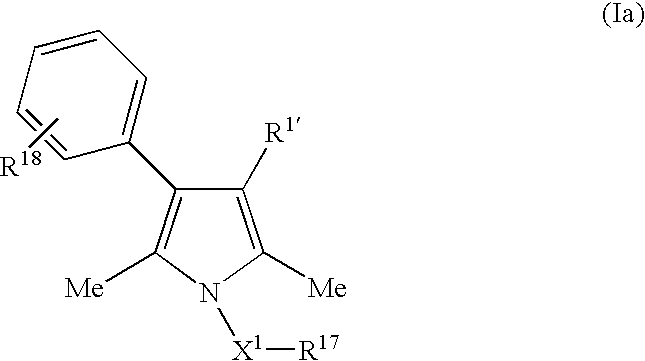Androgen receptor antagonists
a technology of androgen receptor and antagonist, which is applied in the direction of animal repellents, drug compositions, biocide, etc., can solve the problems of hormone-insensitive, recurrent carcinoma, and inability to radical cure the disease, and achieve strong inhibitory activity against a mutant ar, excellent antagonistic activity, and low toxicity
- Summary
- Abstract
- Description
- Claims
- Application Information
AI Technical Summary
Benefits of technology
Problems solved by technology
Method used
Image
Examples
reference example 1
Production of 1-nitro-4-[(1E)-2-nitro-1-propenyl]benzene
[0320] To a mixture of 4-nitrobenzaldehyde (23.9 g) and nitro ethane (30 g) was added n-butylamine (1.2 g) and the mixture was heated at 100° C. for 18 hours. The reaction mixture was concentrated. To the residue was added ethanol and the resulting crystals were collected by filtration. The crystals were further washed with ethanol and diisopropyl ether to obtain the titled compound (15.6 g) as yellow crystals.
[0321]1H-NMR (CDCl3) δ 2.46 (3H, s), 7.60 (2H, d, J=8.7 Hz), 8.09 (1H, s), 8.33 (2H, d, J=8.7 Hz).
[0322] IR (KBr): ν 3113, 3076, 3057, 2984, 2941, 2839, 1599, 1520 cm−1.
reference example 2
Production of Methyl 4-bromo-2,5-dimethyl-1H-pyrrole-3-carboxylate
[0323] To a solution of methyl 2,5-dimethyl-1H-pyrrole-3-carboxylate (6.85 g) and triethylamine (8.7 ml) in dichloromethane (270 ml) was added pyridine perbromohydrobromide (15.7 g) little by little at 0° C. The reaction mixture was stirred at the same temperature for 2 hours and poured into saturated sodium chloride solution. The reaction mixture was extracted with ethyl acetate, and the ethyl acetate layer was dried over magnesium sulfate and concentrated. The residue was purified by column chromatography (carrier: silicagel, eluant: hexane-ethyl acetate) and recrystallized from ethyl acetate-hexane to obtain the titled compound (7.59 g) as yellow crystals.
[0324]1H-NMR (CDCl3) δ 2.19 (3H, s), 2.47 (3H, s), 3.82 (3H, s), 8.20 (1H, s).
reference example 3
Production of Ethyl 4-bromo-3,5-dimethyl-1H-pyrrole-2-carboxylate
[0325] By using ethyl 3,5-dimethyl-1H-pyrrole-2-carboxylate (5.15 g), the reaction and purification were carried out in the same manner as Reference Example 2 to obtain the titled compound (4.43 g) as colorless crystals.
[0326]1H-NMR (CDCl3) δ1.37 (3H, t, J=6.8 Hz), 2.26 (3H, s), 2.28 (3H, s), 4.32 (2H, q, J=6.8 Hz), 9.32 (1H, s).
PUM
| Property | Measurement | Unit |
|---|---|---|
| Reaction temperature | aaaaa | aaaaa |
| Reaction temperature | aaaaa | aaaaa |
| reaction temperature | aaaaa | aaaaa |
Abstract
Description
Claims
Application Information
 Login to View More
Login to View More - R&D
- Intellectual Property
- Life Sciences
- Materials
- Tech Scout
- Unparalleled Data Quality
- Higher Quality Content
- 60% Fewer Hallucinations
Browse by: Latest US Patents, China's latest patents, Technical Efficacy Thesaurus, Application Domain, Technology Topic, Popular Technical Reports.
© 2025 PatSnap. All rights reserved.Legal|Privacy policy|Modern Slavery Act Transparency Statement|Sitemap|About US| Contact US: help@patsnap.com



